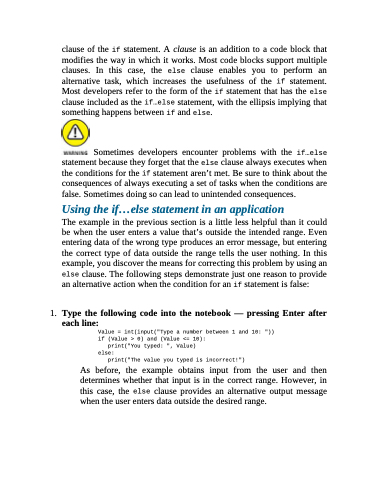Page 173 - Beginning Programming with Pyth - John Paul Mueller
P. 173
clause of the if statement. A clause is an addition to a code block that modifies the way in which it works. Most code blocks support multiple clauses. In this case, the else clause enables you to perform an alternative task, which increases the usefulness of the if statement. Most developers refer to the form of the if statement that has the else clause included as the if...else statement, with the ellipsis implying that something happens between if and else.
Sometimes developers encounter problems with the if...else statement because they forget that the else clause always executes when the conditions for the if statement aren’t met. Be sure to think about the consequences of always executing a set of tasks when the conditions are false. Sometimes doing so can lead to unintended consequences.
Using the if...else statement in an application
The example in the previous section is a little less helpful than it could be when the user enters a value that’s outside the intended range. Even entering data of the wrong type produces an error message, but entering the correct type of data outside the range tells the user nothing. In this example, you discover the means for correcting this problem by using an else clause. The following steps demonstrate just one reason to provide an alternative action when the condition for an if statement is false:
1. Type the following code into the notebook — pressing Enter after
each line:
Value = int(input("Type a number between 1 and 10: "))
if (Value > 0) and (Value <= 10):
print("You typed: ", Value)
else:
print("The value you typed is incorrect!")
As before, the example obtains input from the user and then determines whether that input is in the correct range. However, in this case, the else clause provides an alternative output message when the user enters data outside the desired range.


